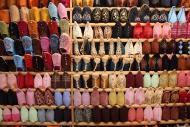Marrakesh is one of the four Moroccan imperial cities and its suq, which extends into the heart of the ancient city (Medina), is one of the most lively in North Africa. Nouns, banners or showcases do not exist. Everything you can see, it is on sale. In the suq, the merchant shows a different behavior with each customer. It develops all around Djemaa el Fna Square, where sales men and artists meet: musicians, orators, prostheses sellers, dentists, snake charmers… But Marrakesh is unforgettable for its fragrances, craftsmen, dyers who wash skins in the stone pits, smiths and the other thousands of magical figures who populate and make unique this African and deeply Arabic-Maghreb city.
The history of the region around Marrakech is linked to the Berber population. Present on the African territory from thousands of years, these people still have a mysterious origin, though it is thought they come from Caucasus. In Roman times, these “men of the earth” had already established the Kingdom of Mauritania, whose borders reached the Mediterranean sea. After the fall of the Roman Empire, they began to grow, up to lead their warriors to the conquest of Spain, bringing Islam to Europe. The imperial city of Marrakech was founded in 1062 by Sultan Ben Youssef Tachfine, who built the defensive walls that surround the city. Extended up to 19 km during the dynasties of Almohades and Saadians these city walls vary from pink to red and are interrupted by 200 square towers (borjs) and nine monumental gates. The prosperity of Marrakech made it the capital of an empire that stretched from Algiers and the Mediterranean to Senegal and the Atlantic ocean.
After 400 years of Berber dynasties, the descendants of indigenous Atlas tribes (the Almoravids, Almohads and Merinides, who reigned until 1465), the sixteenth century saw the advent of the Arab rulers. The Saadians (1554-1603) united Morocco, while in 1659 came to power the Aluites (1672-1727 reigned the Sultan Moulay Ismail), which are still in power in Morocco. One of the most remarkable monuments of Marrakech belonging to this historical Moroccan period is located in the casbah (Qasba). Located in a small garden, the tomb of the Saadian dynasty, dating back to the sixteenth century, are among the best examples of Islamic art, especially the elaborate gypsum decorations and cedar ceilings of the mausoleum.
Travel tip: sit down in a kiosk in Djemaa el Fna Square to enjoy meat, fish, couscous, heads of mutton, snails or kebabs every night from 6pm.

